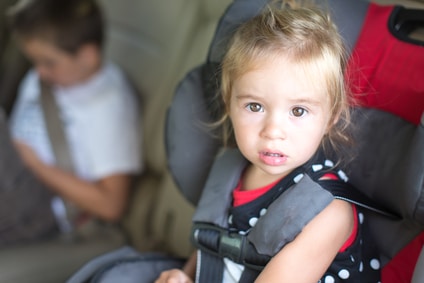- Free Consultation: 866-966-5240 Tap Here To Call Us
Child Safety Seat Laws in California

Child safety seat laws in California are based upon federal regulations and manufacturer recommendations. There can be no more “precious cargo” than our children and proper use of safety seats and boosters can have a major impact on the level of injury and fatalities in motor vehicle collisions involving children in California.

The Basics of California Laws on Child Safety Restraint
Under California’s Child Passenger Safety Law effective January 1, 2012, the following rules apply:
- Children under the age of 8 years must be in a car seat or booster seat in the back seat of the vehicle
- Children who are under the age of 8 but, taller than 4 foot 9 inches, may be secured by a standard three point seat belt so long as they sit in the rear of the vehicle
- Children over the age of 8 or 4’9″ tall or taller may sit in the front or rear of a passenger vehicle so long as they are properly restrained by way of a seat or safety belt
Exceptions to these rules apply in the following circumstances:
- Your vehicle has no rear seats
- The rear seats in your vehicle are side-facing jump seats
- It is impossible to properly affix a child safety seat in the rear of your vehicle (e.g. due to the set up or configuration of the seat belts or if all seats are occupied by children under 12 years old)
- You have a medical reason (verified by a pediatrician) as to why a child cannot sit in the rear of the vehicle
Additionally, the following safety seat guidelines apply depending upon the age and weight of children under 8 years old:
- Newborns and infants under the age of 1 and weighing 20 pounds or less should be placed in a rear facing car seat. The can remain in these rear facing car seats beyond one year or 20 lbs. up until the weight limit specified by the particular seat manufacturer.
- Forward facing seats should have a five point harness system including lower tethers, the seat belt restraint through the middle and the upper tether affixed to the top of the seat and attached to the base behind the seat.
- Booster Seats: These should be used if the vehicle is not equipped with head rests or when the child’s ears are lower than the top of the seat back. Boosters must be used with a lap and shoulder belt and not with a lap belt alone.
Seat Belts for Kids Over 8 Years Old:
Technically, children over 8 or taller than 4’9” tall may be seated in the front or rear of the vehicle and restrained by only a lap and harness belt like an adult. However, the California Highway Patrol and the CA Office of Traffic Safety has stated the following criteria to be used in determining when it is safe to restrain a child with a seat belt alone and no booster or safety seat. These criteria include the following:
- Can the child sit with his or her back against the seat back of the car?
- Do the child’s knees bend naturally over the front edge of the seat when their back is against the back of the bench or bucket seating apparatus?
- Does the lap portion of the seat belt fit low and tight across the top of the thighs of the child?
- Does the shoulder portion of the belt fit across the collar bone and center of the chest?

Child Safety Issues As Basis For CA Rules of the Road Related to Seating of Children in a Vehicle
Proper seat belt and child restraint use is the number one way of reducing serious injury or death among children who are involved in traffic collisions. Additionally, statistics show that the risk if serious injury or death is reduced by approximately 1/3 when children under 8 and less than 4’9” are seated in the rear rather than the front of a motor vehicle.
Additional Resources:
SaferCar.gov – How to Find the Right Car Seat
California Office of Traffic Safety – Seat Belt Guideline
Related Pages on Our Site:
For information or assistance with any car accident claim in California including claims involving minors click here.
For information on the process of presenting a claim for personal injury for a child in California click here.












